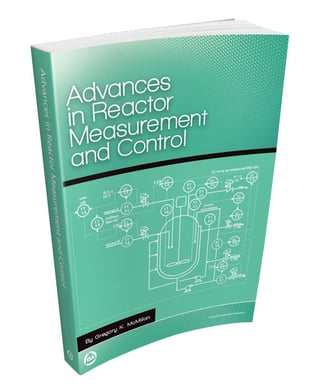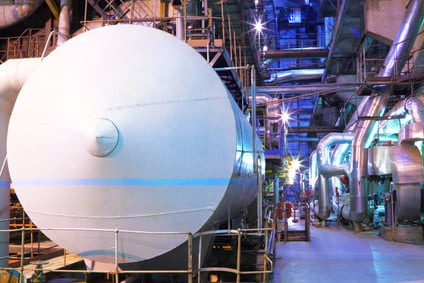This guest post was written by Greg McMillan, industry consultant, author of numerous process control books, 2010 ISA Life Achievement Award recipient and retired Senior Fellow from Solutia Inc. (now Eastman Chemical).
Simple online inferential measurements of cell growth rate, crystal growth rate, and chemical reaction rate are possible using conventional online measurements of flow and temperature. These inferential measurements enable the monitoring and control of process efficiency and capacity. For continuous operations, the indication of product formation rate can be used for maximizing yield at an operating point and making smooth, fast, and efficient transitions to new operating points. For batch operations, the indication of product formation rate can be used to achieve more repeatable batches and make intelligent decisions on batch end points.
A computation of heat removal rate in a cooling system with a sensible heat correction can provide an inferential measurement of conversion rate for exothermic reactors. If there are no significant side reactions, the conversion rate can be taken as being specific to production rate. If the jacket circulation rate is constant and well known, a flow measurement is not necessary.
The heat removal rate (cooling rate) uses temperature sensors on the inlet and outlet of the jacket. The inlet temperature measurement is sent through a dead time block with a dead time setting equal to the transportation delay so the inlet temperature can be synchronized with the outlet temperature.
Resistance temperature detectors (RTDs) provide a more accurate inferential measurement. The heat removal rate is the outlet temperature minus the synchronized inlet temperature multiplied by the jacket flow and the heat capacity of water at the operating temperature. If the jacket circulation flow is not constant, the heat removal computation and the transportation delay must be updated based on a jacket flow measurement. For a constant coil or jacket flow and cooling or chilled water temperature, the difference between the reactor and coil or jacket outlet temperature (approach temperature), can be used as a simpler computation. The integration of the heat removal rate over the batch or for the residence time of a continuous reactor can provide an inferential measurement of total conversion.
The measurement and control of biological and chemical reactors and crystallizers is the key to product quality and the yield and production rate of most processes in the process industry. See Greg's ISA book Advances in Reactor Measurement and Control for an extensive view of practical opportunities for building and effectively using online estimators to improve process knowledge and control.
Wireless temperature transmitters and temperature and pressure compensated annubar mass flow meters can be used to establish the variability in coil and jacket flow and utility temperature besides inexpensively prototyping inferential measurements. The portability of wireless measurements enables one to demonstrate and quantify the benefits of online metrics and diagnostics in less than the time spent in meetings guessing the value and feasibility.
The sensible heat correction can be readily computed. The net sensible heat is computed for each feed stream as the reactor temperature minus the stream temperature multiplied by the stream flow rate and specific heat. The feed sensible heat correction is summation of the net sensible heat for all feed streams. Typically the feed streams are cooler than an exothermic reactor temperature. Part of the heat of reaction goes into bringing the feed added up to the operating temperature. The cooling effect of these streams is added to the heat removal rate to get at a better estimate of the exothermic. If the feed streams are hotter than the reactor, the sign of the correction is negative.
A similar methodology can give an inferential measurement of crystal growth rate. For startup and batch operations, there is an optimum cooling profile. At the beginning of the operation, the cooling rate is kept low to reduce the amount of small crystals (fines) being formed that would end up coating heat transfer surfaces and reducing final crystal size. Toward the end of the batch when crystals are growing rather than forming, the cooling rate is increased to maximize crystal size and minimize batch cycle time.
The computation of an oxygen uptake rate (OUR) can provide an inferential measurement of cell growth rate. Because the Dissolved Oxygen (DO) PID output is continuously adjusted to match the amount of oxygen taken up by cells, the OUR can be roughly estimated from the air or oxygen flow demand when a DO controller is in automatic. A more sophisticated OUR calculation uses a mass spectrometer to measure the amount of oxygen in the off-gas. The oxygen flow rate departing the bioreactor is the off-gas oxygen concentration multiplied by the vent gas flow. The oxygen flow rate entering is the sparge gas oxygen concentration multiplied by the sparge flow. Note that some bioreactors use oxygen besides air in the sparge to meet peak oxygen demand; others use inert gas in the sparge to sweep dissolved carbon dioxide out of the bioreactor. Repeatable, sensitive and low noise flow meters are essential.
For continuous operations, growth and reaction rates are indicative of feed stoichiometry and can be consequently used for improving the ratio control of feeds (e.g. substrates and amino acids for biological reactors, slurries and solvents for crystallizers, and reactants for chemical reactors). For fed-batch operations, a similar opportunity exists. For all batch operations there is an additional opportunity of monitoring and controlling the profile of cell and crystal growth and product formation. See the Control Talk blog Batch Optimization Recommendation Tips for more details. A decision can be made near the end of the batch as to whether to extend the batch for additional yield or end the batch for additional capacity. The next post will discuss how inferential measurements of composition can be built and future values predicted.
For chemical reactors and crystallizers make the most of conventional RTD measurements of coolant in and out temperatures and knowledge of coolant flow to provide a simple online measurement of cooling rate. The resulting reaction rate and crystal growth rate can to be used to increase production efficiency and capacity. For biological reactors (e.g. fermenters), use precise flow meters and if available, an at-line mass spectrometer to provide an oxygen uptake rate that is indicative of cell growth rate.

About the Author Gregory K. McMillan, CAP, is a retired Senior Fellow from Solutia/Monsanto where he worked in engineering technology on process control improvement. Greg was also an affiliate professor for Washington University in Saint Louis. Greg is an ISA Fellow and received the ISA Kermit Fischer Environmental Award for pH control in 1991, the Control magazine Engineer of the Year award for the process industry in 1994, was inducted into the Control magazine Process Automation Hall of Fame in 2001, was honored by InTech magazine in 2003 as one of the most influential innovators in automation, and received the ISA Life Achievement Award in 2010. Greg is the author of numerous books on process control, including Advances in Reactor Measurement and Control and Essentials of Modern Measurements and Final Elements in the Process Industry. Greg has been the monthly "Control Talk" columnist for Control magazine since 2002. Presently, Greg is a part time modeling and control consultant in Technology for Process Simulation for Emerson Automation Solutions specializing in the use of the virtual plant for exploring new opportunities. He spends most of his time writing, teaching and leading the ISA Mentor Program he founded in 2011.
Gregory K. McMillan, CAP, is a retired Senior Fellow from Solutia/Monsanto where he worked in engineering technology on process control improvement. Greg was also an affiliate professor for Washington University in Saint Louis. Greg is an ISA Fellow and received the ISA Kermit Fischer Environmental Award for pH control in 1991, the Control magazine Engineer of the Year award for the process industry in 1994, was inducted into the Control magazine Process Automation Hall of Fame in 2001, was honored by InTech magazine in 2003 as one of the most influential innovators in automation, and received the ISA Life Achievement Award in 2010. Greg is the author of numerous books on process control, including Advances in Reactor Measurement and Control and Essentials of Modern Measurements and Final Elements in the Process Industry. Greg has been the monthly "Control Talk" columnist for Control magazine since 2002. Presently, Greg is a part time modeling and control consultant in Technology for Process Simulation for Emerson Automation Solutions specializing in the use of the virtual plant for exploring new opportunities. He spends most of his time writing, teaching and leading the ISA Mentor Program he founded in 2011.





